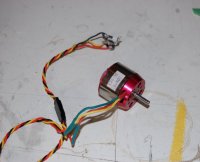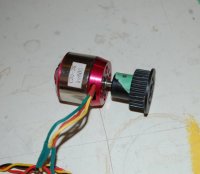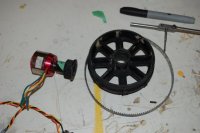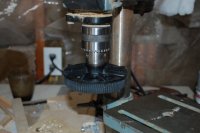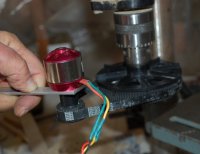You are using an out of date browser. It may not display this or other websites correctly.
You should upgrade or use an alternative browser.
You should upgrade or use an alternative browser.
Scale 50% Dalotel 165
- Thread starter Forgues-Research
- Start date
Forgues-Research
150cc
I will post pictures, but as I said, still in the early stage, but at least I know it works, no secrets either, I'm using a small Brushless motor that use to drive a small propeller. As you know brush-less motors used as an alternator is exactly that , it alternates the voltage , which is AC and not DC. Since its 3 phase, then a bridge rectifier uses 6 diodes, simple enough and you now have a + and - DC voltage output. So far so good, but it needs to spin quite fast similar to your car alternator, Installed it in a dremel tool which spins very fast, but I don't know the RPM, and was getting 21.5 volts DC. I only need 12 volts and 13 is what I want. so I plugged the dremel (with only one speed) into a variac transformer or if you wish a variable output transformer. With the voltmeter connected to the alternator, I increased the rpm of the dremel, it started turning at about 50 volts from the variac. So I increased the voltage to have the dremel turn fast enough until I could read 14 volts. , this of course is with no load, next step I connected a 3 amp lipo charger with a 2s lipo plugged in, switched the dremel on to the preset voltage on the variac, and voila was charging the lipo battery at 3 amps as expected , so now this part is ok and works.
I did find a 4 to 1 toothed belt pulleys I had in the shop with the belt, now to adapt this to mount the large pulley on my small drill press to check if 4000 rpm on the big pulley will be enough , which should give me 16,000 rpm on the alternator, stay tuned
I did find a 4 to 1 toothed belt pulleys I had in the shop with the belt, now to adapt this to mount the large pulley on my small drill press to check if 4000 rpm on the big pulley will be enough , which should give me 16,000 rpm on the alternator, stay tuned
Forgues-Research
150cc
The ripple will very small and will not affect the charger I have already tried with it , so no I don't plan to do anything with itDo you plan to do anything with the ripple?
Forgues-Research
150cc
Forgues-Research
150cc
crude way of testing but it worked, the main pulley is turning at 3100 rpm , so I ran it as you see in the picture and I got about 15.2 volts with no load, which is absolutely perfect., I will try to get a video if I can get someone to help me
Attachments
Toffer77
30cc
I will post pictures, but as I said, still in the early stage, but at least I know it works, no secrets either, I'm using a small Brushless motor that use to drive a small propeller. As you know brush-less motors used as an alternator is exactly that , it alternates the voltage , which is AC and not DC. Since its 3 phase, then a bridge rectifier uses 6 diodes, simple enough and you now have a + and - DC voltage output. So far so good, but it needs to spin quite fast similar to your car alternator, Installed it in a dremel tool which spins very fast, but I don't know the RPM, and was getting 21.5 volts DC. I only need 12 volts and 13 is what I want. so I plugged the dremel (with only one speed) into a variac transformer or if you wish a variable output transformer. With the voltmeter connected to the alternator, I increased the rpm of the dremel, it started turning at about 50 volts from the variac. So I increased the voltage to have the dremel turn fast enough until I could read 14 volts. , this of course is with no load, next step I connected a 3 amp lipo charger with a 2s lipo plugged in, switched the dremel on to the preset voltage on the variac, and voila was charging the lipo battery at 3 amps as expected , so now this part is ok and works.
I did find a 4 to 1 toothed belt pulleys I had in the shop with the belt, now to adapt this to mount the large pulley on my small drill press to check if 4000 rpm on the big pulley will be enough , which should give me 16,000 rpm on the alternator, stay tuned
C'est hors de mes connaissances, je ne comprend pas bien mais je vois que vous vous en sortez à merveille
Bonne continuation et bonne chance.
Christophe.
Forgues-Research
150cc
C'est hors de mes connaissances, je ne comprend pas bien mais je vois que vous vous en sortez à merveille. Félicitations pour votre travail et continuez à nous faire rêver
.
Bonne continuation et bonne chance.
Christophe.
Merci Christophe, ici la traduction par Google
Je vais poster des photos, mais comme je l'ai dit, encore à un stade précoce, mais au moins je sais que cela fonctionne, pas de secrets non plus, je suis en utilisant un petit moteur brushless qui utilisent de conduire une petite hélice. Comme vous le savez moteurs sans balai utilisés comme un alternateur est exactement cela, il alterne la tension, qui est AC et non DC. Depuis sa phase 3, puis un pont redresseur utilise 6 diodes, assez simples et vous avez maintenant un + et - sortie de tension DC. Jusqu'ici tout va bien, mais il doit tourner très vite proche de votre alternateur de voiture, installé dans un outil dremel qui tourne très vite, mais je ne sais pas le RPM, et obtenait 21,5 volts DC. Je dois seulement 12 volts et 13 ce que je veux. donc je branché le dremel (avec une seule vitesse) dans un transformateur de variac ou si vous souhaitez un transformateur de sortie variable. Avec le voltmètre connecté à l'alternateur, je augmenté la vitesse de rotation du dremel, il a commencé à tourner à environ 50 volts de la variac. Donc, je augmenté la tension d'avoir le dremel tourner assez vite jusqu'à ce que je pouvais lire 14 volts. , Cela est bien sûr sans charge, prochaine étape, je raccordé un chargeur lipo de 3 ampères avec une lipo 2S branché, changé le dremel à la tension prédéfinie sur le variac, et voila me charger la batterie lipo à 3 ampères comme prévu, alors maintenant cette partie est ok et des œuvres.
Je l'ai trouver un 4 à 1 poulies dentées je avais dans le magasin avec la ceinture, maintenant d'adapter ce pour monter la grande poulie sur ma petite perceuse pour vérifier si 4000 rpm sur la grande poulie sera suffisant, ce qui devrait me donner 16.000 rpm sur l'alternateur, restez à l'écoute

